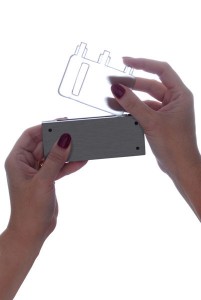The Project:


There’s something very cool about blood cells from the umbilical cord. We’re not medical doctors, but we get that these cord blood cells can turn into pretty much any kind of cell in the human body. These would be useful to have around later in life, to regenerate the blood and immune system after radiation or chemo. There’s also a lot of experimental work using cord blood to treat heart disease, stroke, diabetes, Parkinson’s, spinal chord injury, and Alzheimer’s.
So you probably don’t want to store your new baby’s cord blood in a Ziploc bag in the back of the freezer, between the bag of Parmesan bread crumbs and the Breyer’s Neapolitan. You would turn to a cord blood bank to keep the sample safe for as long as it was needed, which is to say, 40 years to indefinitely.
And where does the cord blood bank turn for the bags they use to store the blood?
You guessed it…
Our client came to us with specs for the bag, and no idea how to get it done. They had been experimenting with welding two sheets of plastic together, but this assembly, while apparently strong enough, could not survive in the freezer. Their engineer contacted us to see if we could develop the part with them.
The Cliff Notes:
The Freezing Bag stores umbilical cord blood cells pretty much indefinitely. It needs to be soft yet incredibly durable, meet all FDA requirements, and translucent enough to allow visual light scanning. And it has to freeze without any degradation in quality. For a really long time.
The Challenges:
Working with FDA-blessed material was the biggest challenge here. We use EVA with polyethylene blended in, as well as a certain percentage of anti-oxidants to meet FDA requirements. Finding the exact ratios that would meet the regulatory and functional requirements took several years.
Our relationship with our client was ideal – they knew nothing about blow molding, so they had no misconceptions. All they had were specs, and we folded our production and process development together into a feedback cycle to give them what they needed. We’d run a set of bags, send them to their device assembler, who would give us feedback on what was working and what still needed improvement.
Since the device that processes cord blood for storage is ridiculously intricate, with over 70 connections between different pieces and tubes, there was a lot of stuff to get right. We’d examine the feedback, modify the mold and/or process, and send them another iteration to test. Imagine our surprise one day, several years after beginning the project, when the feedback was, for the first time, “You nailed it!”
One of the challenges with EVA is that it tends to create gels, little blobs of unmelted resin. The machine we originally used wasn’t capable of creating enough pressure to melt the EVA evenly prior to molding.
The geometry of the bag poses another challenge. Blow molding a thin, flexible rectangle is like trying to blow up a thin rectangular balloon. It’s hard to get it to stretch without bursting at the seams in the corners.
The bag includes three ports at the top. Each port is a different size, and each one must be exactly right. If there were just one port, we could control the process precisely with a blow pin. But with three holes, no such luck. So we create the inside dimensions of the ports solely with the air channeled into them. (Kind of like playing three recorders perfectly without touching them with your lips. Only harder.)
Finally, the bags can deform with rough handling even after they’ve been perfectly molded. So we give as much quality attention to the handling and packing process as the molding process.
Ongoing Quality Control:
Every hour, we pull several bags off the line and make them submit to quality control. We visually examine the Freezing Bag, looking for gels and contaminations (EVA tends toward webbing on the inside). We fold it in half, making sure it’s soft enough.
We weigh the piece with a scale, since any weight discrepancy is an indicator of some other problem.
We check the length and width precisely with a steel rectangular gauge. The bag has to slide through easily without any extra space.
Next, we check the inside diameter of the three ports with a pin gauge.
Finally, we inspect for deformities as we package them for shipping. Every one of those bags will hold precious cord blood for decades, so we do not take any chances.



